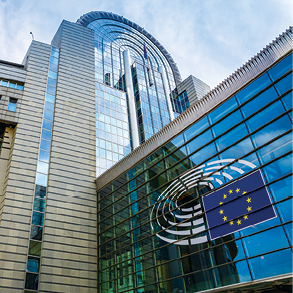The European Geostationary Navigation Overlay Service (EGNOS) will soon launch a new maritime solution that will make legacy and costly coastal ground-based augmentation systems redundant. Meanwhile, the next generation EGNOS V3, featuring dual-frequency, multi-constellation (DFMC) services, is set to come online by 2028, once GPS L5 is declared operational.
Maritime transportation re-mains the backbone of worldwide economic activity, representing 80% of global merchant traffic. Europe is one of the world’s leading maritime hubs, with 329 key seaports and control of about 30% of the world’s merchant fleet.
Shipping around the extensive European coastline relies on differential GNSS (DGNSS) signals for navigation and safety. These signals depend on a network of fixed, ground-based reference stations to broadcast the difference between the positions indicated by GNSS and known fixed positions. Today, almost all commercial GPS receivers, even hand-held units, allow DGNSS data inputs, and DGNSS is commonly used in maritime settings. However, the cost of maintaining this aging infrastructure is high, and the long-standing debate over what to do with this service is unresolved.
Jean-Marc Piéplu, European Geostationary Navigation Overlay Service (EGNOS) Exploitation Program Manager at the EU Agency for the Space Program (EUSPA), told Inside GNSS, “We are developing a new EGNOS service dedicated to Maritime users, which will complement and serve as an alternative to the local DGNSS network currently deployed along the European coasts.”

EGNOS Knows Maritime Transport
Piéplu said EUSPA is targeting 2023 for declaration of the initial EGNOS maritime service, which will then evolve in steps. First, users will be able to access EGNOS corrections via existing aids to navigation (AtoN), using existing EGNOS signal in space (SiS) and/or via the EGNOS Data Access Service (EDAS). Next, standardized, certified receivers will directly access the EGNOS maritime service, using the existing L1 SiS, with some service guarantees. The final service will include a maritime safety message in SiS, if needed, and a multi-system, shipborne, radionavigation receiver (MSR), leveraging the DFMC capability of EGNOS V3, that is, augmented GPS L1/L5 and Galileo E1/E5.
Satellite-based augmentation systems (SBAS), and EGNOS in particular, are already used widely in maritime applications. SBAS corrections have been retransmitted through International Association of Marine Aids to Navigation and Lighthouse Authorities (IALA) beacons in key use cases in France, Estonia and Germany, and most portable pilot units (PPUs) now on the market are EGNOS-enabled. Ninety-three percent of navigation devices used in SOLAS vessels (those that conform to the International Convention for the Safety of Life at Sea) and 89% of navigation devices used in non-SOLAS vessels are EGNOS capable.
Challenges for maritime GNSS and SBAS include signal obstruction and complex multipath effects, especially when other vessels are nearby, and within close, dynamic and varied harbor environments. Intentional interference and spoofing also pose problems.

EGNOS V3
Looking further ahead, over the coming years,” Piéplu said, “the particular challenge for EGNOS is the transition to EGNOS V3, which will replace EGNOS V2, continuing to deliver the current ‘legacy’ safety-of-life services as well as offering new dual-frequency, dual-constellation services. So, it will augment both GPS L1/L5 and Galileo E1/E5. All this we are doing in the frame of a combined safety certification and security accreditation scheme. The entire EGNOS program is gearing up for this transition to the next generation.” The new version will also feature a completely revamped ground infrastructure.
“The equilibrium of the program schedule and budget relies on a successful operations and services transition, from EGNOS V2 to V3,” Piéplu said. “The efforts of the program shall therefore be well balanced and regularly adjusted between preparing the transition to V3 while still investing on V2, to extend its lifetime and improve its capabilities until EGNOS V3 enters into service.”
“The EGNOS V2 system will also be refreshed with more robust ionospheric correction algorithms in 2023, as we launch the maritime service,” Piéplu said. To fulfill its mission, he added, EUSPA is engaging with industry and operators to renew and improve the current infrastructure, to renovate the GEO space segment and to address issues of technical obsolescence within sub-systems.
“We are continually working to make the performance of the system even more robust. This is essential in particular when it comes to ionospheric disturbances, as we are quickly approaching the next solar cycle peak.
“In 2024, Inmarsat 4F2 will be replaced by a new payload on board the Eutelsat E5WB satellite (GEO-3) also improving EGNOS robustness. An additional payload is also expected to be launched in 2022, GEO-4, which will be dedicated to EGNOS V3. DFMC services, that is L5 frequency and augmentation to Galileo, will be provided after GPS L5 FOC.”
Piéplu said the full EGNOS V3 transition should start in 2026–27, first with version 3.1, which will ensure improved performance with the legacy service, and then version 3.2, delivering DFMC service in 2028.
New Governance Arrangements
The recent transition from GSA to EUSPA coincides with the transition to the new EU Space Programme Regulation and the new Financial Framework Partnership Agreement (FFPA) between the Commission, the European Space Agency (ESA) and EUSPA.
“This does not bring major changes in the governance of EGNOS,’ Piéplu explained, “but EUSPA is entrusted with more direct responsibility in the management of operational security and in the direct management of industry for the improvements to the system in operations, currently EGNOS V2. Our relationship with the European Commission and ESA is similar to what it was in the previous phase, but when looking more into details, the new governance arrangements established by the FFPA brings noticeable improvements based on lessons learnt. For instance, we are implementing new ways of working through integrated teams with ESA, and we’ve shortened the decision loops between the exploitation manager (EUSPA) and the industrial team maintaining and improving the operational system.”







